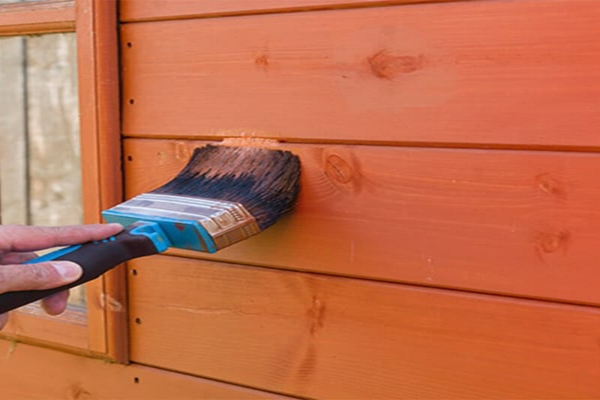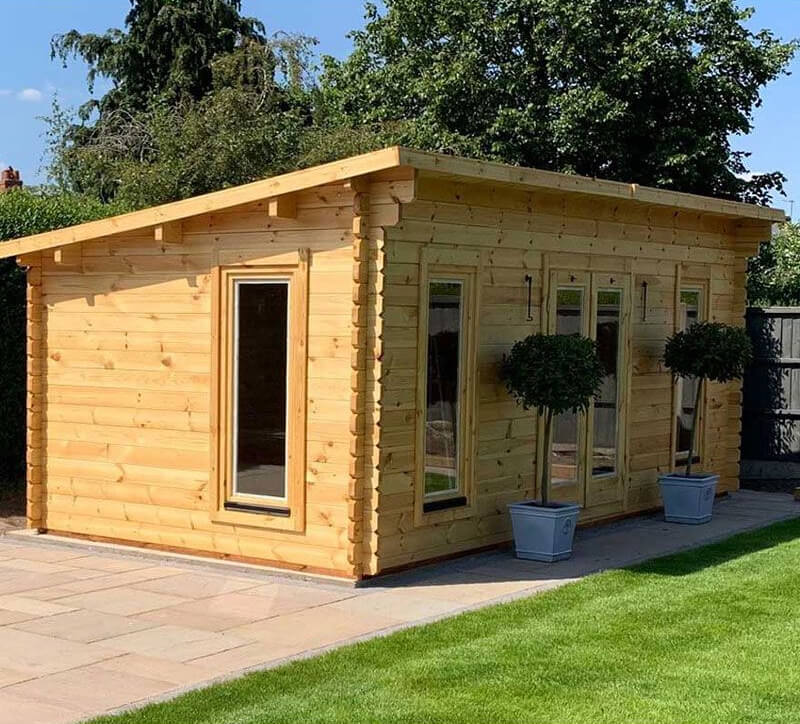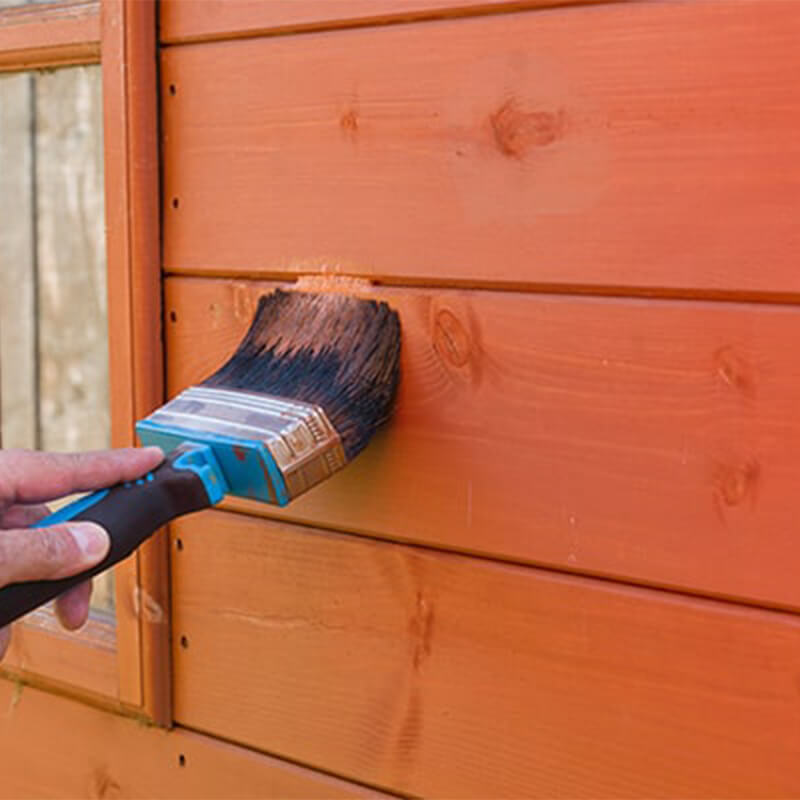
Enjoy your garden's summer appeal when you indulge your garden building with wood treatment for sheds. When you are finally happy with your garden, you have planted all the new plants, mowed the lawn, and cleaned the decking. Your garden feature may be looking a little worse for wear due to the harsh Winters we are seeing more and more frequently. Your shed may have done well but your summer house or Log cabin may have been hit hard. Either way, using a good preservative and shed treatment products will replenish your garden building and restore its defence against outside conditions.
Editor’s Note [26.09.23]: Our guide about how to treat a shed was originally published on January 5, 2017. The update today includes treatment preparation tips, shed protection care tips as well as updates throughout sections of the content.
What is meant by “pressure treatment”?
Firstly, some outdoor buildings do not require any treatment as the smooth timber that has been used to manufacture the shed for example has been pressure treated. Pressure treatment is a process in which a preservative is forced deep into the wood and gives it a green tint.


The wood preservative stops any damage from wood-destroying fungi, wet rot, or dry rot, or pests which saves money in the long run.
Check out our range of pressure treated sheds we have on offer if you want to avoid treating your shed in the future. Most log cabins and summer houses we have on sale are pressure treated for added value for money.
Find out more about the treatment process in our video below:
Importance of Shed Treatment
When it comes to treating, whether it is a pre-existing feature or a new addition, your garden building is an investment, one that provides security for storage or work/relaxation space all year round. Why spend all that money and then not treat your garden shed for it to become susceptible to damage from the weather? Rot is a major issue when it comes to a timber building and something that needs to be prevented at all costs.
Treating the timber will keep a strong core layer that fights off water damage and most of all dreaded rot. Once rot sets in, your building will need fixing and restoring and can be deadly, waking up to a caved-in shed is not ideal.
Wood treatment for sheds preparation
Before embarking on the journey of treating your shed's wood with wood preserver, proper preparation is key to achieving the best results. By following these preparation tips, you will create an optimal environment for applying wooden shed treatments, ensuring your shed remains protected and durable for years to come:
- Allow drying - ensure the wood is completely dry before applying any treatment to prevent trapping moisture
- Apply primer (if needed) - use a wood primer to enhance treatment absorption and improve coverage
- Clean the surface - begin by thoroughly cleaning the shed's exterior wood to remove dirt, debris, and any previous coatings
- Inspect for damage - check for signs of rot, decay, or cracks in the wood that may need repair before treatment
- Protect wooden shed surroundings - cover adjacent areas, garden furniture, and plants to prevent accidental contact with treatment solutions
- Read instructions - familiarise yourself with the chosen treatment's instructions for application techniques and drying times
- Remove hardware - take off door handles, hinges, and other hardware that might hinder even application
- Sand the surface - lightly sand the wooden surface to create a smooth finish that enhances treatment absorption


How to treat a shed
After completing all the necessary preparation tasks as listed above, you are ready to proceed with treating your shed with wood preserver for enhanced durability and protection. The preparation normally takes longer than the treatment with wood preservers:
- Apply the chosen wood treatment - using a brush, roller, or sprayer, evenly apply the selected protective wood treatment across the shed's surface. Ensure that the treatment fully penetrates the wood to provide optimal protection and coverage
- Follow the manufacturer's instructions - once the treatment is applied, allow it to dry in accordance with the manufacturer's recommended drying time. If additional coats are required, ensure that each coat dries adequately before applying the next. Adhere to the manufacturer's guidelines for reapplication to maintain the shed's protective finish and prolong its lifespan
Shed treatment products and ongoing shed maintenance
We sell a range of top-quality wood preservatives that will re-vitalise any old wooden sheds as well as create a resistance for new garden sheds. Applying the wood preservative is as easy as applying shed paint and can be used on smooth or rough sawn timber. You can use a paint sprayer for a fine appliance or use a good old paint brush for a longer treatment process. Either way, your shed will gain a tough resistance to the number one killer, which is rot.


Our best wood preservative can be found here and will provide up to 5 years of resistance for both a shed and fence panel. The treatment is environmentally friendly, having no detrimental effect on your garden and the surrounding environment. A 5 litre tub of wood preserver will treat a standard 8x6 ft shed easily, bear in mind if your shed is larger you will need to buy more so that you have an even spread.
We advise that you treat your garden building as much as possible in respect, once every 2 years for example provides excellent weather protection. We have a variety of coloured wood preservative options available including clear wood preservative as well as harvest gold and dark brown.
Often when garden buildings are delivered, they will come untreated, if that is the case, we advise that you treat them within six weeks so that your shed can build a defence layer. Wood preserver treatment paints can be found at any DIY store and come in a range of colours to suit your preference.
Other tips for shed protection and care
As well as wood treatment for sheds, we also recommend these other shed treatment and shed care maintenance tips to extend the lifespan of your shed or garden building:
- Cleaning - periodically clean your shed's exterior wood using a gentle detergent and water. This helps remove dirt, mould, and other debris that can accumulate over time
- Foundation maintenance - regularly inspect the shed's foundation for shifting or settling Adjust as needed to maintain stability
- Gutter clearing - keep gutters and downspouts clear of debris to ensure proper water drainage and prevent water damage to the shed's foundation
- Hardware care - lubricate hinges, locks, and handles to prevent rust and ensure smooth operation
- Inspect for damage - regularly inspect your shed for signs of damage, including rot, cracks, or loose boards. Address any issues promptly to prevent further deterioration
- Landscape management - trim overhanging branches and vegetation near the wooden shed to prevent moisture accumulation and potential damage
- Painting and staining - if your wooden shed has a painted or stained finish, monitor for peeling or fading. Repaint or restain as needed to maintain both aesthetics and protection


- Pest prevention - implement pest control measures to safeguard against wood boring insects and rodents that can damage your wooden shed
- Roof maintenance - check the roof for leaks, missing shingles, or damage. Repair any issues promptly to prevent water infiltration
- Seasonal preparation - before extreme weather seasons, such as winter, make necessary preparations like sealing gaps, adding weather stripping, and protecting against snow buildup
- Ventilation - ensure proper ventilation to prevent moisture buildup inside the shed. Adequate airflow helps prevent mould and mildew growth
Final thoughts
Maintaining and protecting your garden building is essential to ensure its longevity and appeal. By following proper treatment, care, and maintenance techniques, you can safeguard your investment from the effects of weather, pests, and time. Consistently applying wood treatments, inspecting for damage, and implementing preventive measures will keep your shed, summerhouse, or log cabin in excellent condition for years to come.
Your garden building is more than just a structure— it is a functional and aesthetic addition to your outdoor living space. By prioritising its protection and care, you are not only preserving its beauty but also maximising its usefulness. Whether you are treating a new addition or revitalising an existing feature, the effort you invest in maintenance pays off in terms of durability and enjoyment. Remember, a well-maintained garden building is not only an asset to your property but also a reflection of your dedication to creating a beautiful and functional outdoor environment.
Shedstore contact information
If you need advice about wood treatment for sheds and general shed maintenance, why not contact Shedstore? When you buy our shed treatment products you will have exactly what you need – long lasting wood preservers. Contact our expert team today about how to treat a shed in these ways:
- Phone calls - reach us at 0333 003 0518
- Emails - complete our contact form to share your needs
- Instant text chat - engage in live chat via our app






